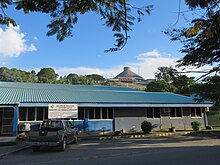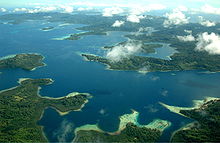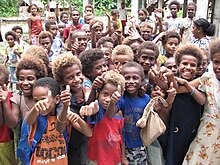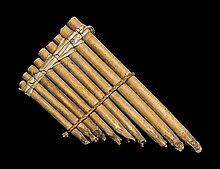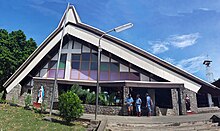Solomon Islands
The Solomon Islands are an independent island country located in Oceania, in traditional Melanesia. It is part of the Commonwealth of Nations. Its territory is made up of more than 990 islands, of which six have a larger area, distributed which are mostly found in the homonymous archipelago, located southeast of Papua New Guinea, and north of Vanuatu. Santa Cruz and Rennell and Bellona Islands lie outside the main archipelago. Its capital and most populous city is Honiara, located on the island of Guadalcanal. It has an area of 28,400 km², and a population of 652,858.
The islands have been inhabited since at least 30,000 BCE. C., with subsequent waves of migrants, mainly from the Lapita culture, giving rise to the current indigenous population. In 1568, the Spanish navigator Álvaro de Mendaña was the first European to visit them, naming them Solomon Islands. Mendaña returned decades later, in 1595, and another Spanish expedition, commanded by the Portuguese navigator Pedro Fernández de Quirós, visited them in 1606. Great Britain defined the Solomon Islands archipelago as an area of interest in June 1893, when Captain Gibson R.N., of the corvette HMS Curacoa, declared the southern Solomon Islands as a British protectorate. During World War II, the Solomon Islands Campaign (1942–1945) resulted in fierce combat between the United States, Commonwealth forces, and the Japanese Empire, including the Battle of Guadalcanal.
The official name of the then British administration changed from British Solomon Islands to Solomon Islands in 1975, achieving self-government the following year. Therefore, independence was achieved, becoming a constitutional monarchy. The Head of State is King Carlos III, represented by the Governor General.
Etymology
The Spanish had heard the Inca legends that spoke of some islands, Anachumbi and Ninachumbi, discovered by the Inca Emperor Túpac Yupanqui and full of treasures. These regions were identified with the Land of Ophir, where the king's mines were located Solomon: despite not having found the expected gold, they called them the Solomon Islands.
History
The islands that make up the Solomon Islands archipelago were settled since the Paleolithic Age, probably around 28,000 BCE. C., from the island of New Guinea. Around the years 4000 a. C., Neolithic peoples from China via the Philippines, the Austronesians, came to populate the entire islands. Archaeological excavations carried out in Salomon show that some 3,000 years later it was home to peoples belonging to the Lapita cultural complex, a Neolithic oceanic civilization that spread through the archipelagos of the western part of the Pacific.
Spanish Explorations
In 1567 an expedition commanded by Álvaro de Mendaña departed from El Callao, taking Pedro Sarmiento de Gamboa and Pedro de Ortega as captains of the ships in search of the Terra Australis Incognita and to study the possibilities of colonization and exploitation of its resources. On February 7, 1568, the two ships of the expedition, Los Reyes and Todos los Santos, arrived at the first of the islands of the archipelago. The island was baptized with the name of Santa Isabel. For six months they explored Isla de Ramos (Malaita), San Jorge (south of Santa Isabel), Florecida, Galera, Buenavista, San Dimas, and Guadalupe islands (Florida group of islands or Nggela Sule), Guadalcanal, Sesarga (Savo), islands of San Nicolás, San Jerónimo and Arrecifes (Nueva Georgia group), San Marcos (Choiseul), San Cristóbal (Makira), Treguada (Ulawa), Tres Marías (Olu Malua), San Juan (Uki Ni Masi), San Urbán (Rennell), Santa Catalina and Santa Ana.
Álvaro de Mendaña tried to prepare a second expedition to the Solomons to colonize them and prevent them from serving as a refuge for English pirates who attacked Spanish ships trading with the Philippines. It was the viceroy of Peru, García Hurtado de Mendoza, who authorized and sponsored the expedition, providing the military, while Mendaña himself convinced merchants and settlers to participate in the company. The ships left El Callao in 1595 and after discovering the Marquesas Islands, named in honor of the viceroy and Marquis of Cañete, and passing through the Cook Islands and Tuvalu, they arrived at the Santa Cruz Islands, south of the Solomons.
The ship Santa Ysabel was lost on the island of Tinakula, however they managed to found a colony, called Puerto de Santa Cruz, in the Santa Cruz Islands, in the current province of Temotu. Soon after, Mendaña fell ill with malaria and the settlers came into conflict with the natives. On October 18, 1595, Mendaña died on the island of Nendö and his wife, Isabel de Barreto, took charge of the colony. After these events, they decided to leave the islands and go to Manila.
After these expeditions, the Spanish lost interest in the islands, although they continued to visit them during the 17th century. There was a new colonizing attempt in 1606, led by Pedro Fernández de Quirós, who refounded the Mendaña colony, but abandoned it with the intention of discovering and exploring Australia, in which he was unsuccessful. The islands were later visited by the British, French and Dutch.
Colonial period
In the mid-nineteenth century, visits by European missionaries followed one another, as did the incursions of the blackbirders, who roamed the islands in search of slave labor for the Queensland plantations, in Australia, and the Fiji Islands. The often brutal and forced recruitment provoked a series of reprisals and massacres by the native population that slowed down European penetration. The abuses of blackbirding led the United Kingdom to enact the Pacific Islanders Protection Act in 1872, known as the Kidnapping Act, which formed the basis for the establishment of the British protectorate over the southern part of the archipelago in 1893, while the northern part was under the jurisdiction of Germany.
As a historical testimony of the German occupation of the Solomon Islands, in 1899 Kaiser Guillermo II ordered the use of a circular punch that was stamped on coins of 5 marks, Philippine pesos of King Alfonso XIII and thalers of María Teresa I from Austria. Said countermark contained a legend that made reference to the king: “W.II.KAISER.SLN.” and date 1899.
In 1899 at the Samoan Tripartite Convention, Germany ceded part of its colonies in the Solomon Islands to the United Kingdom in exchange for recognition of its dominance over the western part of the Samoan Islands. The islands of Buka and Bougainville however remained under German administration as part of German New Guinea, until their occupation by Australian troops at the beginning of World War I. People in Papua New Guinea and the Solomon Islands continue to use the German word Haus instead of the English word "house" as the name of an important building. The reason is that the population got used to using various German words in their languages during German rule. Even today the German word Haus is still used in the names of various buildings and restaurants in Honiara. The building of the Ministry of the Interior, p. For example, it is called Melanesia Pacific Haus.
Traditional exchanges between indigenous British and German Solomon Islands societies continued across colonial borders. Under the protectorate, missionaries settled on the islands and converted most of the population to Christianity.
In the early 20th century, British and Australian companies began creating extensive coconut plantations. But the country's economic growth was slow and had little impact on the well-being of the indigenous people.
The warrior traditions of the Melanesians persisted to a lesser extent under the protectorate until the Japanese invasion in 1942, during World War II. When the fighting began, most of the European settlers were evacuated to Australia and the activity of the plantations, the main resource of the islands, ceased completely. The territory was the scene of a bloody six-month battle, the Battle of Guadalcanal, won by the Americans in 1943. Sixty-seven warships were sunk, the Japanese losing 31,000 men and the Americans 7,000. Native numbers unknown Thanks to their knowledge of the terrain and their courage, the natives actively participated as coastwatchers (coast guards) of the allied intelligence networks, on whose action the outcome of the battle depended to a large extent.
After the war, British colonial rule was restored. The capital Tulagi, which had been destroyed during the war, was replaced by Honiara on the island of Guadalcanal where the Americans had built a military base.
Independence
From 1945 to 1950, an independence movement known as the Maasina Ruru organized campaigns of civil disobedience and strikes on the islands, particularly on the island of Malaita. Its leaders, among whom were the founders of the movement Nori Nono'oohimae, Aliki Nono'oohimae and Jonathan Fiifii'i, were arrested and sentenced to forced labor in 1948. Resistance movements and riots they continued until in 1951 the British began negotiations with the imprisoned leaders (whom they released the same year), and agreed to a form of self-government called the Malaitan Congress. Regional assemblies and a Government Council were created in 1970. Self-government was established in 1976 and independence was proclaimed on July 7, 1978; the new state entered the Commonwealth of Nations (Commonwealth of Nations). Its political regime is the constitutional monarchy, and its monarch, Carlos III of the United Kingdom.
The strong rivalries between the islands triggered a civil revolt that brought the country to an almost complete halt: public workers suffered arrears in the collection of salaries for months, and government meetings had to be held in secret to prevent meddling in them of the military leaders. The security forces were unable to regain control, largely because many of the police and other security forces belonged to one or the other of the rival groups.
In July 2003, the Governor General of the Solomon Islands made an official appeal to the international community for help, which was later supported by the government. An international security contingent of 2,200 police and military, organized by Australia and New Zealand and involving citizens of twenty other Pacific nations, began arriving the following month, dubbed Operation Helpem Fren. The Australian contribution was called Operation Anode.
Government and politics
Solomon Islands is a parliamentary monarchy within the Commonwealth of Nations. King Charles III of the United Kingdom is also King of the Solomon Islands, which is represented by the Governor General. Executive power is entrusted to a cabinet headed by a prime minister.
Legislative power rests with the National Parliament, which is unicameral and is made up of 50 members elected in majority single-member districts.
Some of the country's problems are corruption, government deficit, deforestation and malaria control.
Human Rights
Homosexuality is illegal in the Solomon Islands.
In terms of human rights, regarding membership of the seven bodies of the International Bill of Human Rights, which include the Human Rights Committee (HRC), Solomon Islands has signed or ratified:
Territorial organization
Solomon Islands is divided into 9 provinces, run by Provincial Assemblies and a capital territory, run by the Honiara City Council. They have local government functions.
Temotu Province, located in the Santa Cruz Islands, as well as Rennell and Bellona, are the only provinces that do not belong to the Solomon Islands archipelago.
Geography
The Solomon Islands occupy part of the archipelago they share with the state of Papua New Guinea. The main islands are: Choiseul, the New Georgia Islands, Santa Isabel, the Russell Islands, the Florida Islands, Malaita, Guadalcanal, Sikaiana, Maramasike, Ulawa, Uki, San Cristóbal, Santa Ana, Rennell and Bellona and the Santa Cruz Islands. The archipelago as a whole has an area of 28,450 km², which for comparison purposes is similar to that of Albania.
The distance between the westernmost and easternmost islands is about 1,500 kilometers, taking into account that the Santa Cruz Islands are more than 200 kilometers from the other islands of the country, to the north of the Vanuatu Islands. Volcanoes, of varying degrees of activity, are located on some of the larger islands, while several of the smaller islands are simply tiny atolls covered in sand and coconut palms.
Economy
Most of the population depends on subsistence agriculture, fishing, and forestry for at least part of their livelihood. Most manufactured goods and oil must be imported. The islands are rich in mineral raw materials such as lead, zinc, nickel, and gold. Economic problems in Southeast Asia led to a sharp decline in the logging industry, with economic output falling by about 10% in 1998. The Government instituted wage reductions in the public service and other sectors. The economy partially recovered in 1999, thanks to rising gold prices on the world market and the Gold Ridge mine's first full year of operation. However, in the middle of the year, the closure of the country's largest palm oil plantation cast a shadow over future prospects. The disastrous political situation does not facilitate economic growth.
Many families grow taro (2017: 45,901 tons), rice (2017: 2,789 tons), yams (2017: 44,940 tons) and bananas (2017: 313 tons) for their own consumption and for sale. in local markets. In addition, tobacco (2017: 118 tons) and condiments (2017: 217 tons) are grown to meet local demand.
Demographics
According to the CIA World Factbook, the population of the Solomon Islands is estimated to be 622,469 in 2015. According to 2009 figures, the majority population is ethnic Melanesian (95.3%). There are also communities of Polynesian (3.1%) and Micronesian (1.2%) ethnicity. The inhabitants live mostly in rural areas and 22.3% in urban areas.
Culture
In traditional Solomon Islands culture, traditional customs are passed down from one generation to the next, supposedly through ancestral spirits, to form Solomon Islands cultural values.
In the Solomon Islands today, as in other parts of Melanesia, kastom is the core affirmation of traditional values and cultural practices in a modern context. The Kastom Gaden Association, for example, defends and encourages the cultivation and consumption of traditional foods instead of imported ones.
Plastic arts
Pottery making is not very developed in the Solomon Islands as most of the islands do not have clay deposits suitable for pottery production. Formerly there was pottery on some islands in the north of the country, similar to that of the Neolithic Lapita culture, but today only the population of Choiseul Island continues to produce pottery.
The most important raw material for Solomon Islands plastic arts is wood, which is not a very durable material in the country's humid climate. Wood carving has a long tradition in the Solomon Islands. Often the motifs consist of gods and demons from mythology. In many cases they were decorated with mother-of-pearl, especially the nguzunguzu. These are figureheads from war canoes. The National Museum in Honiara has a large collection of traditional-style wooden sculptures. In the buildings of the University of the South Pacific in Honiara there are several columns ornate with wooden sculptures in the traditional style of the islands and also the church All Saints' Church in Honiara features impressive wooden sculptures. In the Cathedral of the Holy Cross there are two large wooden statues of Saint Mary and Saint Joseph created by artist Frank Haikiu, a native of Honiara.
The motifs in traditional painting consist of animals, such as fish and turtles in many cases. Several Solomon Islands churches are adorned with wall paintings in the traditional style with profusion of colours. These wall paintings show the saints or various scenes from the Bible and the people represented have the traditional hairstyle and clothing of the islands.
Language
The official language is English, which is the language of 10,000 people on the islands, and is used as a second language by 165,000. The lingua franca is pijin (Solomons Pidgin or Neo-Solomonic in English), a pidgin spoken by 307,000 Solomonians and related to New Guinea Tok Pisin and Vanuatu Bislama. There are also 75 local languages of which 4 are extinct languages and 8 on the verge of extinction. In pijin there are still some German words, since a part of the Solomon Islands archipelago was a colony German until 1899 and the population became accustomed to using various German words in their languages. For example, the German word Haus is still used instead of the English word "house" as the name of an important building. The German word Haus occurs in the names of several buildings and restaurants in Honiara. The building of the Ministry of the Interior, p. For example, it is called Melanesia Pacific Haus. The Noodle Haus ("Casa de las Pastas") is a well-known restaurant in Honiara, and next to St. Barnabas Cathedral is the Melanesia Haus that it is a cultural center.
Education
25% of the Solomon population is illiterate. Although primary education is free, since it is not compulsory, only 60% of children attend class. As for secondary education, since it is not free, the cost of enrollment, uniforms, transport and textbooks makes it difficult for schoolchildren of humble origins to attend. The educational infrastructures have suffered major damage during the civil disturbances of the years 1998-2003 and the tsunami of 2007, and despite the fact that reconstruction works have been undertaken throughout the country, the educational system still fails to reach the entire population. Many schools have poor facilities and there are not enough textbooks or school supplies. Half of the primary school teachers are unqualified and less than half of the schools have potable water.
In 2005, the country had 537 primary schools. For secondary education, it had 10 state, 15 provincial and 111 municipal centers. Primary and secondary schools operated by religious entities represent an important part of the educational system and many are subsidized by the State. There is a state body in charge of higher vocational training (after completion of secondary education), the Solomon Islands College of Higher Education (SICHE), with 3 campuses in Honiara, one in Malaita and one in the Western Province. This type of training is also provided by centers dependent on municipalities, religious organizations and NGOs.
Solomon Islands is home to two universities, the University of the South Pacific (University of the South Pacific - USP), based in Fiji, and the University of Papua New Guinea (University of Papua New Guinea - UPNG), based in Port Moresby. Both have a regional campus in Honiara, and UPNG also has four provincial centers.
Media
Due to the great linguistic variety of the islands, the low level of literacy and the difficulties of receiving TV signals, the most widespread means of communication is radio. The country has one public broadcaster, the Solomon Islands Broadcasting Corporation (SIBC), with two national channels, Radio Happy Isles and Wantok FM, and one provincial, Radio Happy Lagoon. There is a private station, PAOA FM. SIBC operates the only TV channel in the Solomon Islands, but channels can be picked up via satellite.
The press includes a national daily, the Solomon Star, and a daily online newspaper, the Solomon Times Online. There are also two weekly, Solomons Voice and Solomon Times, and two monthly, Agrikalsa Nius and Citizen's Press.
Infrastructure
The country's main airport is Honiara International Airport, which lies to the east of the capital. It is the base of operations for Solomon Airlines, the country's flag carrier. It has direct flights to Nadi (Fiji), Port Vila (Vanuatu) and Brisbane (Australia), as well as 20 domestic airports located in each province of the country. To promote tourism Solomon Airlines has introduced a direct connection between Brisbane and Munda in 2019. Virgin Australia connects Honiara to Brisbane twice a week. Most of the domestic airports are only accessible to small planes, since the runways are short.
Religion
96% of the Solomon Islands are Christian. The majority of Christians, 73.4%, are Protestants: Church of Melanesia (Anglicans), 31.9%; Evangelical Church of the South Seas (Evangelicals), United Church in Papua New Guinea and the Solomon Islands, 10.1%; Christian Brotherhood Church 2.5%. Some 11.7% of the population of the Solomon Islands are members of the Seventh-day Adventist Church. The Church of the Province of Melanesia, a branch of the Anglican Church, was founded in 1849 by George Augustus Selwyn of New Zealand. Initially it was the Church of the Province of New Zealand, but in 1975 it became an independent church and encompassed the Solomon Islands, Vanuatu and New Caledonia in the south-west Pacific. The church's seat is the Cathedral of Saint Barnabas in Honiara. Originally All Saints' Church, a church built in 1971 that features interesting wooden carvings, was the cathedral for that church. Catholics make up 19.6% of the population. The Roman Catholic Archdiocese of Honiara was founded on 22 December 1978. Its cathedral, the Holy Cross Cathedral was built between 1975 and 1978. About 4% of the Solomon Islands population They are believers of indigenous religions.
Sports
Soccer is the most popular sport in the country, the Solomon Islands Soccer Federation is in charge of managing the Solomon Islands national soccer team, it is a member of the OFC and FIFA. At the continental level, it is one of the strongest teams in Oceania, while at the world level, it is one of the weakest teams. As for the OFC Nations Cup, it achieved a historic runner-up in 2004.
The national league is the S-League (so called for advertising reasons), it is made up of 8 teams that face each other in 2 rounds. The current champion is Koloale FC. The S-League has a place in the OFC Champions League.
Soccer modifications (beach soccer and indoor soccer) are also very popular on the islands. In these two sports, Solomon Islands is the most powerful at the continental level and one of the teams that usually takes part in the World Cups, both in futsal as in beach soccer, despite the fact that the performances of the Solomon Islands Futsal Team and the Solomon Islands Beach Soccer Team often have poor campaigns in these tournaments.
In 2012, the country hosted the OFC Nations Cup, after it was decided in March that the previously chosen venue, Fiji, did not meet the requirements. Other popular sports are rugby, baseball, swimming, and surfing.
Contenido relacionado
Vermellar
Napoleon III Bonaparte
Nepal




